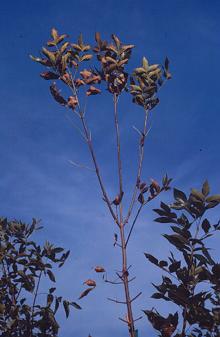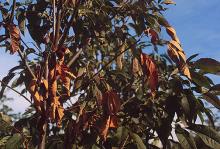See:
Maple (Acer spp.) - Verticillium Wilt
Cause Verticillium dahliae, a soilborne fungus that, once established in the soil, is almost impossible to eradicate due to microsclerotia that germinate and infect roots. The fungus grows into the xylem where it colonizes the plant through mycelial growth and conidial production. Fluid movement in the xylem passively transports the conidia. Once in the xylem, this fungus partially blocks water movement and produces toxins that result in wilt symptoms. After diseased plant parts die, microsclerotia form and live several years in soil. Many weeds are susceptible and can help the fungus survive and disperse.
Symptoms Ash rarely produces the wilting and vascular discoloration common to other hosts such as maple. Foliage turns light green and chlorotic followed by a leaf scorch and premature defoliation. Older leaves seem to defoliate first, according to observations from local nurseries. Upper branches die back in a random or one-sided distribution on the tree. Branches tend to die back in summer after the first heat stress of the year. Trees infected in the nursery often develop symptoms within 1 to 3 years after planting but can remain symptomless for longer periods. Symptom expression will vary in intensity from year to year.
As the Emerald Ash Borer makes its way through the PNW it could be mistaken for Verticillium wilt. Send samples to a laboratory for accurate diagnosis.
Sampling Send soil samples to any of various private and public laboratories to assay for Verticillium propagules. Nurseries may wish to test individual core samples to determine the distribution in a particular field. The presence of any microsclerotia in the soil should be interpreted as a potential disease risk.
Cultural control
- Clean pruning equipment after use.
- Keep nitrogenous fertilizers to a minimum-enough only to produce normal, not succulent, growth.
- If the tree dies and/or is removed, replace it with a nonsusceptible host such as any conifer, birch, dogwood, or sycamore.
- Avoid planting ash in fields with a history of Verticillium wilt. Avoid fields previously planted to other hosts such as potato or tomato.
- A preplant soil test for Verticillium propagules will help determine a planting site.
Chemical control Fungicides are not effective.
References Worf, G.L., Spear, R.N., and Heimann, M.F. 1994. Verticillium-induced scorch and chlorosis in ash. Journal of Environmental Horticulture. 12:124-130.
Heffer, V.J., and Regan, R.P. 1996. First report of verticillium wilt caused by Verticillium dahliae of ash trees in Pacific Northwest nurseries. Plant Disease 80:342.



